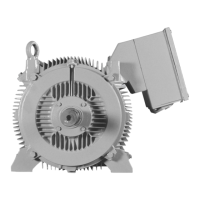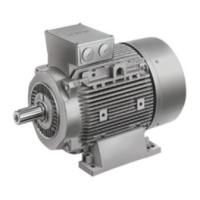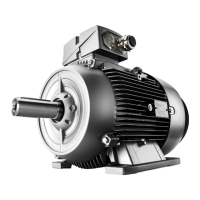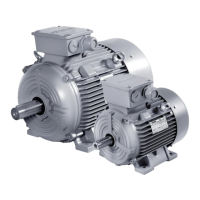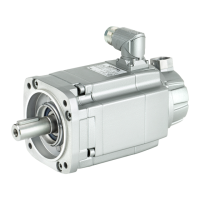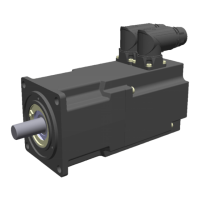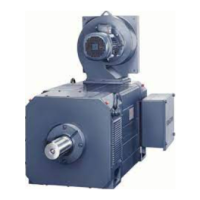Do you have a question about the Siemens 1LA8 Series and is the answer not in the manual?
Defines warning symbols and terms used in the documentation.
Explains the meaning of different danger levels indicated by warning symbols.
Emphasizes safe operation and qualified personnel for electrical equipment.
Outlines essential safety responsibilities for operating electrical machines.
Discusses zonal classification and operational risks in potentially explosive environments.
Provides safety instructions regarding electromagnetic interference.
Details items included in the delivery and complaint procedures.
Provides contact information for technical support and further inquiries.
Describes the general applications and versatility of the 1LA8 series motors.
Details the motor's construction, standards, cooling, and components.
Lists terminal box types used for different motor models and their specifications.
Covers safe practices for transporting, storing, and handling the motor.
Provides critical safety instructions before and during motor installation.
Details the necessary steps and expertise for proper motor alignment.
Explains requirements for stable foundations, alignment, and component balancing for mounting.
Details how to properly connect the ground conductor according to standards and torques.
Provides detailed specialist knowledge required for correct alignment and mounting.
Discusses noise considerations and the function of water drain holes.
Covers bearing specifications and requirements for installation surfaces.
Details measures for compensating radial offset and horizontal adjustment.
Specifies tightening torques for cable lugs and earth terminals.
Guides on connecting power cables, checking data, and terminal box closure requirements.
Details earthing procedures and insulation resistance measurement.
Instructions for connecting supply cables and auxiliary circuits.
Explains how phase sequence affects rotation direction.
Guides on using cable lugs for motor connections.
Details connecting fine-wire conductors without cable lugs.
Recommends procedures for aluminum conductors and discusses single-stranded cables.
Guides on cable entry, routing, and strain relief.
Details tightening strain relief clamps and checking gaskets.
Explains PE ground connection and lists final checks before closing terminal box.
Addresses converter connection, temperature sensors, and PE conductors for grounded networks.
Outlines safety precautions and checks before commissioning the motor.
Lists essential checks after assembly and before system commissioning.
Recommends monitoring stator winding temperature using embedded sensors.
Provides steps for safely energizing the motor during commissioning.
Describes energizing, load testing, and monitoring motor operation.
Details measures to be taken when de-energizing the motor.
Emphasizes monitoring vibration and temperature for safe operation.
Discusses activating anti-condensation heating during de-energization.
Covers safety precautions for operating machines and cleaning.
Provides guidance on motor stoppages, anti-condensation heating, and pre-recommissioning lubrication.
Introduces the fault diagnosis tables for mechanical and electrical issues.
Lists electrical fault characteristics, possible causes, and remedial measures.
Lists mechanical fault characteristics, possible causes, and remedial measures.
Covers safety rules, precautions, and preparations for motor maintenance.
Details bearing types, lubrication, and grease specifications for motors.
Guides on relubricating with sealing grease for increased protection.
Provides instructions for servicing, inspecting bearings, and handling faults.
Specifies criteria for the first service after installation or repair.
Outlines service criteria for main maintenance after extended operation.
Covers safety instructions and notes for preparing motor overhauling or repairs.
Guides on safely dismantling motor components, including drive elements and fans.
Details handling and replacement of rolling-contact bearings.
Covers seal replacement, re-assembly, and proper lubrication of surfaces.
Provides instructions for assembling bearing seals, including V-rings.
Guides on mounting plastic radial fans and fan cowls.
Details bolt locking methods and tightening torques for various connections.
Explains how to order spare parts using motor details.
Provides a detailed exploded view of the motor with part numbers and designations.
Explains why separate fans are used and their function.
Guides on connecting the blower motor, optional encoder, and assembly.
Provides instructions for dismantling and reassembling the fan cowl and unit.
Lists motor, bearing, terminal box, and fan components with part numbers.
Shows an exploded view of the components for motors with separately driven fans.
Defines warning symbols and terms used in the documentation.
Explains the meaning of different danger levels indicated by warning symbols.
Emphasizes safe operation and qualified personnel for electrical equipment.
Outlines essential safety responsibilities for operating electrical machines.
Discusses zonal classification and operational risks in potentially explosive environments.
Provides safety instructions regarding electromagnetic interference.
Details items included in the delivery and complaint procedures.
Provides contact information for technical support and further inquiries.
Describes the general applications and versatility of the 1LA8 series motors.
Details the motor's construction, standards, cooling, and components.
Lists terminal box types used for different motor models and their specifications.
Covers safe practices for transporting, storing, and handling the motor.
Provides critical safety instructions before and during motor installation.
Details the necessary steps and expertise for proper motor alignment.
Explains requirements for stable foundations, alignment, and component balancing for mounting.
Details how to properly connect the ground conductor according to standards and torques.
Provides detailed specialist knowledge required for correct alignment and mounting.
Discusses noise considerations and the function of water drain holes.
Covers bearing specifications and requirements for installation surfaces.
Details measures for compensating radial offset and horizontal adjustment.
Specifies tightening torques for cable lugs and earth terminals.
Guides on connecting power cables, checking data, and terminal box closure requirements.
Details earthing procedures and insulation resistance measurement.
Instructions for connecting supply cables and auxiliary circuits.
Explains how phase sequence affects rotation direction.
Guides on using cable lugs for motor connections.
Details connecting fine-wire conductors without cable lugs.
Recommends procedures for aluminum conductors and discusses single-stranded cables.
Guides on cable entry, routing, and strain relief.
Details tightening strain relief clamps and checking gaskets.
Explains PE ground connection and lists final checks before closing terminal box.
Addresses converter connection, temperature sensors, and PE conductors for grounded networks.
Outlines safety precautions and checks before commissioning the motor.
Lists essential checks after assembly and before system commissioning.
Recommends monitoring stator winding temperature using embedded sensors.
Provides steps for safely energizing the motor during commissioning.
Describes energizing, load testing, and monitoring motor operation.
Details measures to be taken when de-energizing the motor.
Emphasizes monitoring vibration and temperature for safe operation.
Discusses activating anti-condensation heating during de-energization.
Covers safety precautions for operating machines and cleaning.
Provides guidance on motor stoppages, anti-condensation heating, and pre-recommissioning lubrication.
Introduces the fault diagnosis tables for mechanical and electrical issues.
Lists electrical fault characteristics, possible causes, and remedial measures.
Lists mechanical fault characteristics, possible causes, and remedial measures.
Covers safety rules, precautions, and preparations for motor maintenance.
Details bearing types, lubrication, and grease specifications for motors.
Guides on relubricating with sealing grease for increased protection.
Provides instructions for servicing, inspecting bearings, and handling faults.
Specifies criteria for the first service after installation or repair.
Outlines service criteria for main maintenance after extended operation.
Covers safety instructions and notes for preparing motor overhauling or repairs.
Guides on safely dismantling motor components, including drive elements and fans.
Details handling and replacement of rolling-contact bearings.
Covers seal replacement, re-assembly, and proper lubrication of surfaces.
Provides instructions for assembling bearing seals, including V-rings.
Guides on mounting plastic radial fans and fan cowls.
Details bolt locking methods and tightening torques for various connections.
Explains how to order spare parts using motor details.
Provides a detailed exploded view of the motor with part numbers and designations.
Explains why separate fans are used and their function.
Guides on connecting the blower motor, optional encoder, and assembly.
Provides instructions for dismantling and reassembling the fan cowl and unit.
Lists motor, bearing, terminal box, and fan components with part numbers.
Shows an exploded view of the components for motors with separately driven fans.
